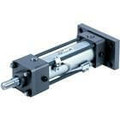Actuators convert energy into motion, functioning as the muscles in machinery by generating force and movement. Their applications range from simple machinery adjustments to complex robotic systems. It is crucial for you to choose the right type of actuator—be it pneumatic, hydraulic, or electric—to ensure optimized performance and efficiency in your operations.
Pneumatic actuators, like air cylinders, utilize compressed air to exert force, offering a reliable and clean solution for many automation tasks. Electric actuators, including electric linear actuators, use electrical energy to create motion and are favored for their precise control capabilities. Hydraulic actuators, on the other hand, use fluid power to perform heavy-duty tasks where high force output is required. Specialty types, such as piezoelectric actuators, utilize materials that expand or contract when electric voltage is applied, ideal for finely tuned applications.
Choosing the Right Actuator for Your Application
Step 1: Determine Motion Requirements
Begin by identifying whether your application requires linear or rotary motion. Each type of actuator offers distinct advantages depending on the movement pattern needed. This step is crucial as it directly impacts the efficiency and effectiveness of your operation.
Step 2: Assess Environmental and Load Requirements
Consider the operating environment and the load the actuator must handle. Environmental factors like dust, moisture, and temperature extremes can influence the choice of actuator, as some are better suited than others to withstand harsh conditions. Additionally, understanding the load capacity and force requirements ensures that the actuator will not falter under operational demands.
Step 3: Evaluate Precision and Speed
Lastly, consider the necessary precision and speed of the actuator. For applications involving high-speed automation or repetitive tasks, selecting an actuator with high repeatability and accurate control systems is essential. This ensures that each cycle of operation is consistent, contributing to the overall quality and reliability of your process.









